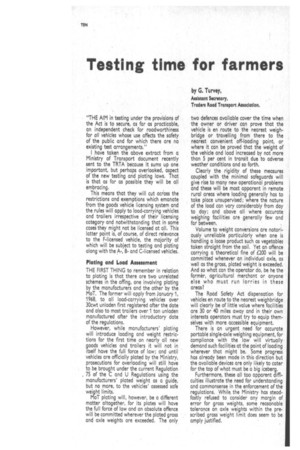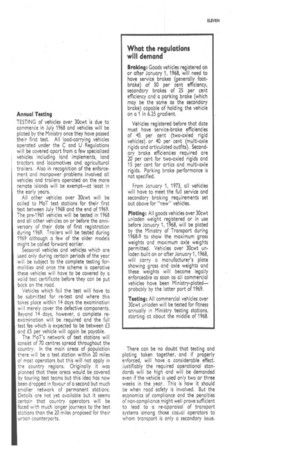Testing time for farmers
Page 78

Page 79

If you've noticed an error in this article please click here to report it so we can fix it.
"THE AIM in testing under the provisions of the Act is to secure, as for as practicable, an independent check for roadworthiness for all vehicles whose use affects the safety of the public and for which there are no existing test arrangements."
I have taken the above extract from a Ministry of Transport document recently sent to the TRTA because it sums up one important, but perhaps overlooked, aspect of the new testing and plating laws. That is that as far as possible they will be all embracing.
This means that they will cut across the restrictions and exemptions which emanate from the goods vehicle licensing system and the rules will apply to load-carrying vehicles and trailers irrespective of their licensing category and notwithstanding that in some cases they might not be licensed at all. This latter point is, of course, of direct relevance to the F-licensed vehicle, the majority of which will be subject to testing and plating along with the A-, Band C-licensed vehicles.
Plating and Load Anessment THE FIRST THING to remember in relation to plating is that there are two unrelated schemes in the offing, one involving plating by the manufacturers and the other by the MoT, The former will apply from January 1, 1968, to all load-carrying vehicles over 30cwt unladen first registered after the date and also to most trailers over 1 ton unladen manufactured after the introductory date of the regulations.
However, while manufacturers' plating will introduce loading and weight restrictions for the first time on nearly all new goods vehicles and trailers it will not in itself have the full force of law; and until vehicles are officially plated by the Ministry, prosecutions for overloading will still have to be brought under the current Regulation 75 of the C and U Regulations using the manufacturers' plated weight as a guide, but no more, to the vehicles' assessed safe weight limits. MoT plating will, however, be a different matter altogether, for its plates will have the full force of law and an absolute offence will be committed wherever the plated gross and axle weights are exceeded. The only
two defences available cover the time when the owner or driver can prove that the vehicle is en route to the nearest weighbridge or travelling from there to the nearest convenient off-loading point, or where it can be proved that the weight of the vehicle and load increased by not more than 5 per cent in transit due to adverse weather conditions and so forth.
Clearly the rigidity of these measures coupled with the minimal safeguards will give rise to many new operational problems and these will be most apparent in remote rural areas where loading generally has to take place unsupervised; where the nature of the load can vary considerably from day to day; and above all where accurate weighing facilities are generally few and far between.
Volume to weight conversions are notoriously unreliable particularly when one is handling a loose product such as vegetables taken straight from the soil. Yet an offence carrying a theoretical fine of £200 will be committed whenever an individual axle, as well as the gross, plated weight is exceeded. And so what can the operator do, be he the farmer, agricultural merchant or anyone else who must run lorries in these areas?
The Road Safety Act dispensation for vehicles en route to the nearest weighbridge will clearly be of little value where facilities are 30 or 40 miles away and in their own interests operators must try to equip themselves with more accessible equipment.
There is an urgent need for accurate portable single-axle weighing equipment, for compliance with the law will virtually demand such facilities at the point of loading wherever that might be. Some progress has already been made in this direction but the available devices are only likely to cater for the top of what must be a big iceberg.
Furthermore, these all too apparent difficulties illustrate the need for understanding and commonsense in the enforcement of the regulations. While the Ministry has steadfastly refused to consider any margin of error for gross weights, some reasonable tolerance on axle weights within the prescribed gross weight limit does seem to be amply justified.
Annual Testing TESTING of vehicles over 30cwt is due to commence in July 1968 and vehicles will be plated by the Ministry once they have passed their first test. All load-carrying vehicles operated under the C and U Regulations will be covered apart from a few specialized vehicles including land implements, land tractors and locomotives and agricultural trailers. Also in recognition of the enforcement and manpower problems involved all vehicles and trailers operated on the more remote islands will be exempt—at least in the early years.
All other vehicles over 30cwt will be called to MaT test stations for their first test between July 1968 and the end of 1969, The pre-1961 vehicles will be tested in 1968 and all other vehicles on or before the anniversary of their date of first registration during 1969. Trailers will be tested during 1969 although a few of the older models might be called forward earlier.
Seasonal vehicles and vehicles which are used only during certain periods of the year will be subject to the complete testing formalities and once the scheme is operative these vehicles will have to be covered by a valid test certificate before they can be put back on the road.
Vehicles which fail the test will have to be submitted for re-test and where this takes place within 14 days the examination will merely cover the defective components. Beyond 14 days, however, a complete reexamination will be required and the full test fee which is expected to be between and a per vehicle will again be payable.
The MoT's network of test stations will consist of 70 centres spread throughout the country. In the main areas of population there will be a test station within 20 miles of most operators but this will not apply in the country regions. Originally it was planned that these areas would be covered by touring test teams but this idea has now been dropped in favour of a second but much smaller network of permanent stations. Details are not yet available but it seems certain that country operators will be faced with much longer journeys to the test stations than the 20 miles proposed for their urban counterparts.
There can be no doubt that testing and plating token together, and if properly enforced, will have a considerable effect. Justifiably the required operational standards will be high and will be demanded even if the vehicle is used only two or three weeks in the year. This is how it should be when road safety is involved. But the economics of compliance and the penalties of non-compliance might well prove sufficient to lead to a re-appraisal of transport systems among those casual operators to whom transport is only a secondary issue,












































































































































